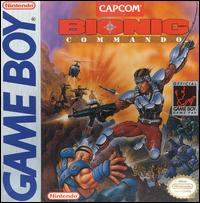This article needs additional citations for verification .(January 2025) |
| Bionic Commando | |
|---|---|
 North American cover art | |
| Developer | Minakuchi Engineering |
| Publisher | Capcom |
| Series | Bionic Commando |
| Platform | Game Boy |
| Release | |
| Genre | Platform |
| Mode | Single-player |
Bionic Commando [a] is a 1992 platform video game developed by Minakuchi Engineering and published by Capcom for the Game Boy. It is an adaptation of the Nintendo Entertainment System version of Bionic Commando , changing the present-day setting of the NES version into a futuristic science fiction one.
Contents
The game has been re-released via the Nintendo 3DS Virtual Console service in 2011 and the Nintendo Classics service in November 2025. [1] [2]
